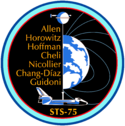STS-75
| STS-75 | |||||
 | |||||
| Uppdrag | 75 | ||||
|---|---|---|---|---|---|
| Rymdfärja | Columbia (19)[1] | ||||
| NSSDC-ID | 1996-012A[2] | ||||
| Färdens tid | 15 dagar, 17 timmar, 40 minuter, 22 sekunder | ||||
| Uppskjutning | |||||
| Startplats | Startplatta 39B vid Kennedy Space Center i Florida | ||||
| Start | 22 februari 1996, 20:18:00 UTC | ||||
| Landning | |||||
| Landningsplats | KSC, Runway 33 | ||||
| Landning | 9 mars 1996, 13:58:22 UTC | ||||
| Omloppsbana | |||||
| Varv | 251 st[3] | ||||
| Apogeum | 320 km | ||||
| Perigeum | 277 km | ||||
| Banlutning | 28,45° | ||||
| Sträcka | 10,5 miljoner km | ||||
| Besättning | |||||
| Befälhavare | Andrew M. Allen (3) | ||||
| Pilot | Scott J. Horowitz (1) | ||||
| Uppdragsspecialister | Jeffrey A. Hoffman (5) Maurizio Cheli (1) ESA Italien Claude Nicollier (3) ESA | ||||
| Nyttolastspecialister | Franklin R. Chang-Diaz (5) Umberto Guidoni (1) Italien | ||||
 | |||||
| Kronologi Rymdfärjeprogrammet | |||||
| |||||
STS-75 var en flygning i det amerikanska rymdfärjeprogrammet med rymdfärjan Columbia. Den sköts upp från Pad 39B vid Kennedy Space Center i Florida den 22 februari 1996. Efter drygt femton dagar i omloppsbana runt jorden återinträdde rymdfärjan i jordens atmosfär och landade vid Kennedy Space Center.
Se även
Referenser
- ^ NASA Space Shuttle Launch Archive Arkiverad 2 juni 2007 hämtat från the Wayback Machine., läst 28 juli 2016.
- ^ ”NASA Space Science Data Coordinated Archive” (på engelska). NASA. https://nssdc.gsfc.nasa.gov/nmc/spacecraft/display.action?id=1996-012A. Läst 20 mars 2020.
- ^ Manned Astronautics - Figures & Facts Arkiverad 16 augusti 2016 hämtat från the Wayback Machine., läst 28 juli 2016.
Externa länkar
 Wikimedia Commons har media som rör STS-75.
Wikimedia Commons har media som rör STS-75.
| ||||||||
| ||||||||||||||||||||||||||||||||
Media som används på denna webbplats
Författare/Upphovsman: Pascal (Flickr user: pasukaru76), Licens: CC0
Vostok spacecraft replica at the Technik Museum Speyer, Germany.
The crew assigned to the STS-75 mission included (seated left to right) Scott J. Horowiz, pilot; Andrew M. Allen, commander; and Franklin R. Chang-Diaz, mission specialist. Standing, left to right, are Maurizio Cheli, mission specialist of the European Space Agency (ESA); Umberto Guidoni, payload specialist (Italy); Jeffrey A. Hoffman, mission specialist; and Claude Nicollier, mission specialist (ESA). Launched aboard the Space Shuttle Columbia on February 22, 1996 at 3:18:00 pm (EST), the STS-75 mission carried two primary payloads; the reflight of the U.S./Italian Tethered Satellite System (TSS-1R), and the U.S. Microgravity Payload-3 (USMP-3).
STS-76 Mission Insignia
STS-72 Mission Insignia
STS-75 Mission Insignia






